There was a time when walking the halls of a museum was a gateway to another world, or several. It was like entering different time periods with each hall you turned down. Relics from an ancient time spoke to the cultures and civilizations that had long ago faded from the Earth. However, the practise of filling a museum with artifacts found in foreign lands was fraught with moral peril. Western archeologists were accused of plundering the historical pieces from other nations and putting them on display. There was (and still is) an ethical dilemma with how we approach museums. Museum, the new game from Éric Dubus and Olivier Melison takes place in the golden age of archeology and repatriation of relics from distant lands. You’ll be tasked with building an enticing collection in your museum, but you’ll also face the backlash of public opinion throughout the game.
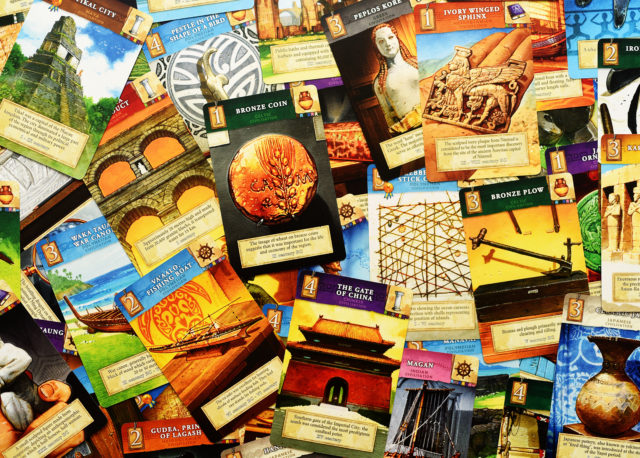
In Museum, you’ll take turns being the active player, collecting items from around the world. The main board displays artifact cards from Europe, China, South America, and Africa and the Middle East. The cards each have nation of origin (denoted by its colour) and a domain which it belongs to, such as Architecture, Warfare, Agriculture, or Theology. The cards also have a point value, which you’ll earn for placing it in your museum, and it also represents the cost of playing that card out.
You’ll start off with a card from each of the different world regions in your hand, a Favour card which can be used to give you a special ability during the game and three Patron cards of which you’ll choose one. The Patron cards give you secret end game goals, like having a lot of cards from a certain civilization or specific combinations of artifacts.
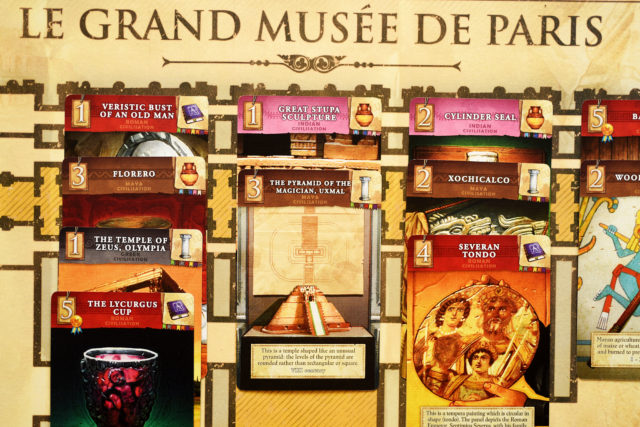
Each turn when you’re the active player, you’ll get to select one of the cards on offer. Usually there are two from each region for eight total cards to choose from. After you’ve made your selection. Every other player can decide to take one from the remaining lot as well. If they do, you earn a point for each one. This is known as the Exploration phase.
Next, you can either Furbish your museum or perform an inventory. Most of the time, you’re going to furbish. First of all, it’s just a fun word to say, but on top of that it’s the main action of the game. When you furbish you can start to fill up your museum with different exhibits. From your hand, you can exhibit a card by paying its cost in other cards. For example, if you want to add the Dunhaung Map, a value three card, you must spend other cards from your hand totalling three. So, three value ones, or a one and a two. You get the idea. The used cards go to your common pool (think of this as your warehouse). You can add cards to your museum from your common pool, or even someone else’s pool, but you have to pay them a point if you do so. You get points equal to the value of the cards you place in your museum immediately.

The last thing you can do when you furbish is hire an expert. They have a value to them and you hire them by spending cards equal to their value. These experts help with completing patron goals, or give an in-game bonus like reducing the cost of exhibiting in your museum. Suffice to say, they’re all helpful in their own way.
The much less exciting action you can take is performing an inventory, If you can’t furbish, you can take cards from your common pool back into your hand.
There are times throughout the game when the opinions of the public turn against museums, and that can have long-lasting consequences. When refilling the different regions between turns, you may reveal a Public Opinion card. This means people are upset with the amount of artifacts being taken from a region and not being put on display. A public opinion token is placed in that region. Short term, it means you have one less card to choose from that round. Long term, having that region’s cards in your common pool at the end of the game will cost you points.
At the start of each round, a headline card is revealed. This will have some effect on the game for the rest of the round. They’re all tied to to actual historic events, like a mystery death or Africa at war, so they work well thematically.
When one player reaches 50 points, game end is triggered. All other players get one more turn and then points are tallied. At the end of the game, you can organize your museum exhibits in any way you want, so there’s no pressure in making a mistake early in the game. You’ll get points for the different civilization and domain collections you’re able to make, fulfilling some layout requirements in your museum, and completing your patron cards. You lose points for having cards in your common pool from regions with public opinion tokens against them.
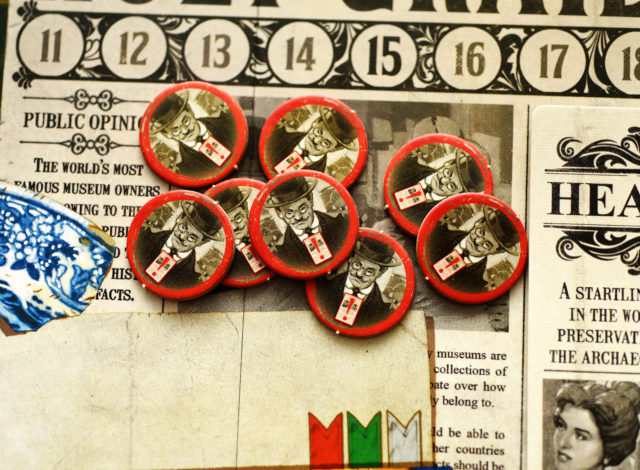
There are a lot of things I like about Museum. First, it’s freakin beautiful. The always amazing Vincent Dutrait has done a great job with the art. The main board and the museum boards are fairly plain, allowing the artifacts to shine. Speaking of the artifact cards, they all have some informative flavour text that makes the game a little bit more interesting. While there is a lot going on, Museum really is a simple game: collect sets of artifacts, arrange them in your museum, react to events and the swaying of public opinion. To me, it feels a little like 7 Wonders in the way you’re drafting cards and putting together sets. They have a similar weight, and as far as I can tell so far, a similar replayability factor. I think there is a lot of combinations and strategies to explore in this one and I’m eager to get it to the table as often as I can.
That being said, don’t take my word for it. We have our very own resident museum expert at the DWP and Nicole is ready to give her input on the game:
Some of you might not know, but I’m a bit of a nerd for museums. Having studied them, visited many and worked in them I was quite excited to hear about Museum when it first hit Kickstarter. I’ve been thinking for many years about what a museum game could be, and jotting down notes here and there from the perspective of student, visitor and staff to see if I could one day replicate what I know of modern museums. Museum doesn’t fit entirely in what I’d been thinking about, as it’s set in that early era of museums where the focus was certainly on massing collections and displaying exotic pieces.
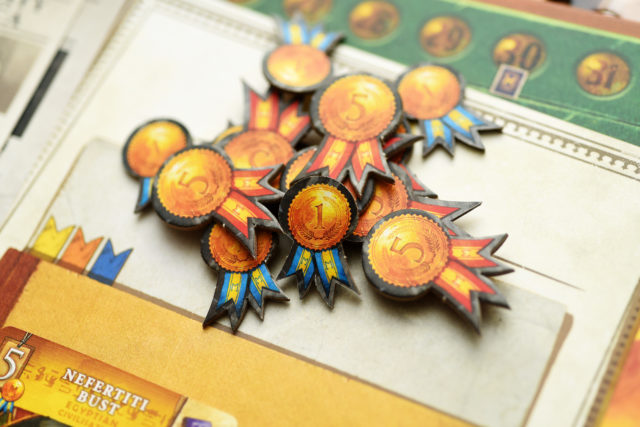
I do, of course, think the art of this game is incredible – Dutrait does it again. While it’s disappointing there’s only cultural pieces included in the base game and nothing to do with Natural History, I enjoy the pieces selected. While some of them are strange choices – the Great Wall of China, for instance – I do enjoy the variety and the snippets of information at the bottom of each card. They are, after all, just like some museum’s labels! So playing every time gives you some new and interesting facts about things you may not have known before.
Thematically, the scoring of cards at game-end is pretty great. Whether on display or in collections storage, it’s pretty important to group objects by their culture or type. Perhaps I could head into our Anthropology collections where I work to see Plains Indians artefacts – but at the same time, wouldn’t it be cool to have a gallery consisting of examples of pottery from varying cultures? The methods and approaches of this in museums the world over varies wildly of course, depending on the size and focus of the institutions, but it generally hits the mark well in the game to have your displays organized in these ways. One thing I did think was interesting was the cycling of cards between your personal reserve (hand), common pool (discard) and taking from both to place into galleries. It doesn’t quite translate to the ideas of how collections are held exactly – but it was a neat mechanic.
While there are no representatives of the cultures from which the game’s artefact decks are comprised, there are some folks in the game in the form of experts (and hey, there’s a woman on the cover!). I love the range of these cards, because it reflects the variety of folks that you’ll find in a museum (or at least, a Victorian or Edwardian Era one). Experts in certain types of objects or civilizations will boost your displays – but then you might have someone who can talk up your museum to provide more prestige or even help along with the acquisition of items for galleries at a cheaper price. Fantastic flavour piece!
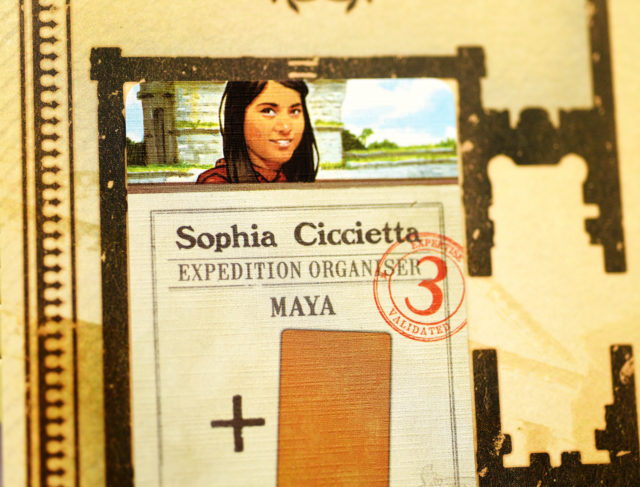
Somewhat unfortunately accurate for the time period is the wholesale pillagings of cultural objects from the world-round. During the era of the wunderkammer and the popularisation of anthropological studies, the demands for museums to show these foreign cultural pieces were high. Perhaps where my interests lie is somewhere along the road from this, as most reputable institutions nowadays are collecting artefacts through far more reasonable means. I did like the instances of headline cards including embargos and customs barriers, as the exploration of Europeans around the world could at least sometimes go awry.
I have yet to crack the stack of expansions that I received with my Kickstarter pledge. I have to admit, one or two of them aren’t super appealing to me as I’m very much into reality in my museum stuff – Cthuhlu doesn’t feel super great to me in there, and although there were certainly black markets for artefacts when the game is set, I don’t like the idea of including that in gameplay. Much more up my alley are the ideas of the Archaeologists and World Fair, providing some more interesting cards for me to “visit” and read the labels of!
————-
A copy of Museum was provided by Holy Grail Games and Luma Imports for this review.
Comments
No comments yet! Be the first!